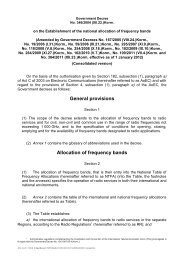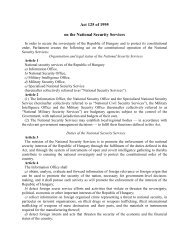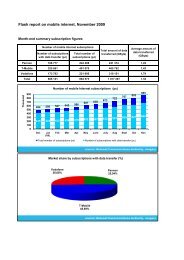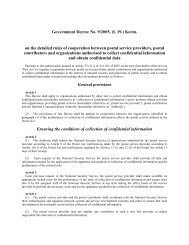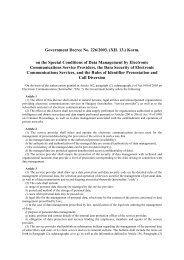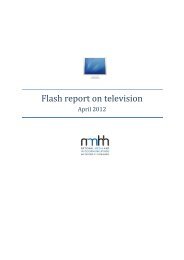The Hungarian Communications Market Developments and ...
The Hungarian Communications Market Developments and ...
The Hungarian Communications Market Developments and ...
You also want an ePaper? Increase the reach of your titles
YUMPU automatically turns print PDFs into web optimized ePapers that Google loves.
<strong>The</strong> <strong>Hungarian</strong> <strong>Communications</strong> <strong>Market</strong> <strong>Developments</strong> <strong>and</strong> Regulation between 2004 <strong>and</strong> 2008<br />
<strong>The</strong> situation in Hungary is similar, with T-Mobile realising only<br />
a minimal drop in market share (slightly more than one percentage<br />
point) over the past three years. Vodafone having presented dynamic<br />
growth in the first years of its operation cannot, for the time being,<br />
considerably exceed the twenty percent market share. Moreover,<br />
during the last two years, its share has somewhat decreased. Consequently,<br />
the structure of the <strong>Hungarian</strong> market <strong>and</strong> the dynamics<br />
of market shares are very similar to the EU average.<br />
In a European comparison, the prices of <strong>Hungarian</strong> mobile service<br />
providers were significantly lower in nominal terms in 2007 than the<br />
EU average. <strong>Hungarian</strong> service providers are cheaper than the EU<br />
average 34 in the case of the small consumer basket (30 calls, 33 SMS<br />
monthly) by more than ten percent, while in the case of the medium<br />
consumer basket (65 calls, 50 SMS) <strong>and</strong> the large consumer basket<br />
(140 calls, 55 SMS monthly) by twenty percent. This indicates a high<br />
level of competition in the <strong>Hungarian</strong> market <strong>and</strong> makes it unlikely<br />
that regulatory problems will arise in the retail market.<br />
4.4 Regulation of leased line markets<br />
Leased line service is the most frequently used service producing<br />
the highest revenue in the domestic data transmission market. In the<br />
market of leased line services, competition started in the early 90’s,<br />
with alternative service providers appearing in the market already at<br />
that time. However, competition intensified in the second half of the<br />
90’s, with lower <strong>and</strong> lower prices <strong>and</strong> increasingly larger share of<br />
alternative service providers.<br />
Numerous services can be added to retail leased lines, which the<br />
leased line retail service provider provides for customer on the basis<br />
of the leased line service. <strong>The</strong>se output services for instance include<br />
transmission services using ATM (Asynchronous Transfer Mode)<br />
<strong>and</strong> Frame Relay, VPN (Virtual Private Network) services or IP-based<br />
services. <strong>The</strong> conditions of competition in <strong>and</strong> the regulation of the<br />
leased line market may also influence the sale of these added data<br />
transmission services.<br />
<strong>The</strong> growth rate of the different segments of the leased line retail<br />
market varies according to the b<strong>and</strong>width of digital services. <strong>The</strong><br />
market of services with broader b<strong>and</strong>width showed more dynamic<br />
growth in the past years than that of services with smaller<br />
b<strong>and</strong>width. <strong>The</strong> retail sales revenue resulting from services with a<br />
b<strong>and</strong>width of more than 2 Mbit/s has seen a sixfold increase from<br />
2004 to 2007, with a growth of fifty percent in the case of services<br />
with a b<strong>and</strong>width of less than 2 Mbit/s in the same period (although<br />
net revenue was still about three times higher than in the higher<br />
b<strong>and</strong>width segment). By 2007, the sales revenue of the whole retail<br />
market reached HUF 20 billion.<br />
In many cases, service providers providing retail services have<br />
only certain own segments of the claimed leased line. Consequently,<br />
for the provision of leased lines offered, such service providers must<br />
also use leased line trunk or termination segments of other service<br />
providers, to be obtained through wholesale transactions.<br />
<strong>The</strong> leased line trunk segment is a leased line section between<br />
two points of presence of the operator, while the leased line section<br />
exp<strong>and</strong>ing from the network end-point situated at the location of<br />
the subscriber to the nearest point of presence of the other service<br />
provider is called the leased line termination segment. <strong>The</strong> volume of<br />
the service provider sales revenue realised in the wholesale markets<br />
(leased line termination <strong>and</strong> trunk segment) was close to HUF 17<br />
billion in 2007.<br />
<strong>The</strong> competition in the different segments of retail leased line services<br />
is different to some extent. In general, in the case of services<br />
with higher b<strong>and</strong>width (above 2 Mbit/s), alternative service providers<br />
provide their retail services through the rollout of individual networks,<br />
so in this market competition is more intense than in the market of<br />
services with lower b<strong>and</strong>width, where alternative service providers<br />
are often forced to use the wholesale services of the incumbent<br />
service provider.<br />
Regulation of leased line markets<br />
In the first <strong>and</strong> second rounds of market analysis, the Board performed<br />
the analysis of three leased line markets, in accordance with<br />
the relevant Decree of the Ministry of Informatics <strong>and</strong> Telecommunication<br />
(<strong>and</strong> in conformity with the recommendation of the European<br />
Union).<br />
In its decisions of 2005 <strong>and</strong> 2008, the Board identified the trunk<br />
segment market (market 14) as a country-wide market susceptible<br />
to ex-ante regulation <strong>and</strong> established that no service providers with<br />
significant market power could be identified in this market, therefore,<br />
it did not impose any obligations. Also in 2005 <strong>and</strong> 2008, the Board<br />
made decisions as regards the country-wide markets susceptible<br />
to ex-ante regulation of retail (market 7) <strong>and</strong> termination segments<br />
(market 13). <strong>The</strong>n it established that the competition was ineffective<br />
<strong>and</strong> Magyar Telekom had significant market power. In order to<br />
restrict its market power, the Board imposed obligations.<br />
Minimum set of leased lines<br />
<strong>The</strong> analysis of the Board established that in the retail leased line<br />
market it was the SMP service provider that had a network capable<br />
of providing the most extended service. Duplication of this network<br />
in the short term is unrealistic, therefore, there is a risk of the SMP<br />
service provider refusing the provision of services. Taking advantage<br />
of its role as market-leader, the service provider may, in some cases,<br />
provide low quality services for the same prices; consequently, there<br />
is a risk of low-level services <strong>and</strong> quality reduction.<br />
<strong>The</strong> main objectives of the Board was to prevent the SMP service<br />
provider from abusing its market power <strong>and</strong> ensure customers’ access<br />
to an adequate supply <strong>and</strong> quality of leased line retail services.




